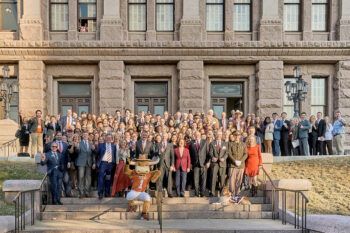Texas A&M, UT Leverage Each Other’s Strengths

Representatives from Texas A&M University and The University of Texas recently took to the State Capitol, showcasing how the flagship universities are united in the belief that prioritizing higher education helps the state face its challenges and improves the lives of its residents.
The event, celebrating its 20th year, allows delegates from both Tier 1 flagship universities to share common legislative priorities with members of the Texas Legislature.
Texas A&M University System Chancellor John Sharp, A&M President M. Katherine Banks, The Association of Former Students President and CEO Porter S. Garner III and UT-Austin President Jay Hartzell were among the leaders in attendance.
“This day, each legislative session, Aggies and Longhorns come together to advocate for the shared goals of the universities and higher education to state legislators,” Banks said. “The need for an affordable, high-quality higher education that meets the demands of our future workforce has never been more important, and we’re pleased to see former students from our two schools come together in this way.”
The five priorities relayed to legislators include:
- Invest in the academic missions of the University of Texas and Texas A&M. State formula funding directly supports the core academic mission of the two flagship universities — educating students. The costs of educating students have increased over time, creating greater strain on students and families of Texas. Stable and predictable state funding helps to keep college affordable and promotes efficiency and consistency for the universities, students and families.
- Increase investment in Texas-based research initiatives.Advocates are asking officials to enhance the funding rate for the Texas Research University Fund and maintain the funding level for the Governor’s University Research Initiative. Stronger investment in research aimed at solving the complex challenges facing our state stimulates the state’s economy and creates invaluable opportunities for students to gain hands-on, practical experience in their chosen fields while receiving instruction from world-class faculty.
- Make investments to support the innovations and productions of semiconductors in Texas. Last summer, Congress passed legislation allowing for $52 billion to be spent on American semiconductor research, development, manufacturing and workforce development. This funding will help secure domestic supply chains, create tens of thousands of jobs, and catalyze hundreds of billions more in private investment. A state investment in this area will uniquely position Texas to compete for the $13 billion in federal research and development funds and become a national leader in the semiconductor industry. Combined, respective funding for the Texas Institute for Electronics (TIE) and the Texas A&M Engineering Experiment Station (TEES) will enable the state to address national defense and secure commercial production challenges.
- Invest in student mental health services. With more students seeking mental health services, the costs of these services have increased by 76 percent at Texas A&M since 2020 and are projected to increase by an additional 150 percent by 2025.
- Fully fund military veteran legacy education benefits through the Texas Hazlewood Act. Honor the legislature’s commitment to our military veterans, as created in the Hazlewood Act, by fully funding costs specifically associated with children of eligible service men and women — referred to as “legacy” beneficiaries. The Hazlewood Act, enacted by the Legislature in 1943, is a State of Texas benefit that provides tuition exemptions for qualified military veterans with up to 150 hours at public institutions of higher education.
The cost for Hazlewood exceptions at Texas A&M is about $30 million, with more than $23 million attributable to the more than 2,000 legacy students last year.
Scot Walker, vice president of The Association of Former Students, said the Texas Legislature has been very generous to Texas A&M and UT-Austin and receptive to hearing the two flagship universities’ shared legislative priorities.
“Orange and Maroon Legislative Day is very important to strengthening relationships between our state’s lawmakers and the leadership of the universities and their alumni associations, as well as the many current and former students who help advocate for higher education in Texas,” Walker said.
For more information or to get involved, visit tx.ag/AdvocacyNetwork.
Media contact: Kelly Brown, kelly.brown@tamu.edu




